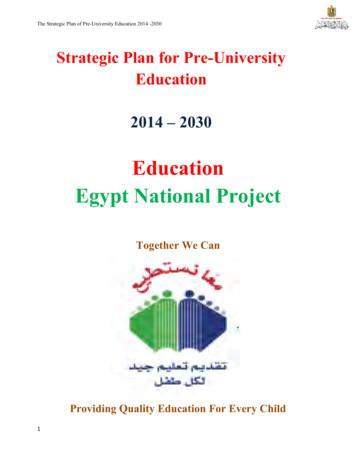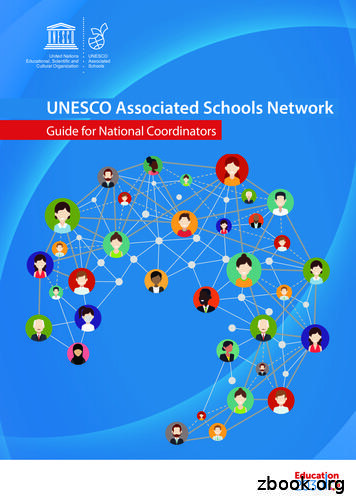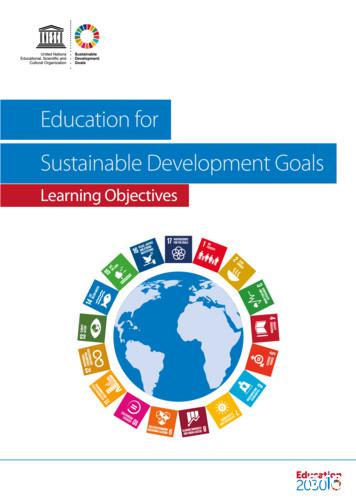Education Egypt National Project - UNESCO
The Strategic Plan of Pre-University Education 2014 -2030Strategic Plan for Pre-UniversityEducation2014 – 2030EducationEgypt National ProjectTogether We CanProviding Quality Education For Every Child1
Strategic Plan of Pre-University Education 2014 -2030Foreword by His Excellency the Minister of EducationThe essence of Ministry of Education (MoE) vision revolves around the provision of human resources, enjoyingan increasing capacity and efficiency as well as the highest degree of quality and professional ethics, aiming atbuilding learning –based society and knowledge-based economy. To this end, the Ministry upholds a mission ofleading, managing and developing the pre- university education sector to respond to the social, economic andcultural needs of the Egyptian society. The mission further seeks maintaining the national identity, inseparablefrom global approaches. Hence, the long-term goal for the sector is the holistic development of young people,instilling the principles and values of citizenship, tolerance, renunciation of violence, freedom and justice,taking in consideration related rights and obligations in addition to the sense of responsibility towards nationand fellow citizens.The immediate goal is to underscore the commitment of ensuring every child’s right to equally receive qualityeducational service in accordance with international standards, allowing every child to contribute effectively tosocial and economic development of the country, and compete regionally and globally. To achieve the aforementioned, three reform and developmental policies have already been adopted inconsistence with United Nations Charter for Human Rights, namely:Providing equal opportunities for all school-age population to enroll for and complete education, both thegeneral and technical education, while targeting poor areas as a top priority.Improving the educational services effectiveness, through: the provision of contemporary curriculum;efficiently employed information technology; educational sports and non- sports activities; effective teacher forevery child in each classroom; impactful leadership in every school; internal and external opportunities forprofessional development for all teachers and administrators in order to advance and excel.Strengthening the institutional infrastructure, especially in technical schools, and building the capacity of staffto implement decentralization in a way to ensure good governance.Consistent with the current government approach, the Ministry of Education developed a 3-years phased planbeginning in the year 2014/2015 as a foundation for a strategic plan to end in 2030. Such phased plan isdesigned based on the analysis of multiple data including: evaluation of the previous strategic plan, stakeholders2
The Strategic Plan of Pre-University Education 2014 -2030input, international reports and related literature, as well as opinions of specialists from the education sector ornot. It has also been guided by the plans of some other countries.A highly experienced locally and internationally trained team of MoE cadres drafted the interim plan, supportedby: experts in pedagogical planning, and professionals in various pedagogical and educational disciplines fromresearch centers and colleges of education in Egyptian universities along with a selection of specialists from theNational Institute for Planning, the Ministry of Planning and the National Authority for Quality Assurance andAccreditation. This endeavor is part of a continuous participatory process with the student community, teachers,and pedagogical cadres at various levels, in addition to Civil Society Organizations (CSOs). Moreover,technical and material support has been provided by UNICEF, UNESCO, and the UNESCO InternationalInstitute for Educational Planning, in collaboration with the United States Agency for InternationalDevelopment, and the British Council.In designing the plan programs, due consideration was given to the results obtained at the returns level and toincorporate the structural inputs with a matrix of financial and moral incentives within a framework oftransparency and accountability. Such is to be accomplished via an efficient and effective use of availablematerial and human resources, involving the private sector and civil society as acting partners, in order tomaximize such resources, together with international institutions and other countries of interest in educationalcooperation and sharing of experiences. In addition to the previously mentioned, an ongoing application ofmedium-term expenditure framework was also observed, balancing the programs as being a methodologylinking policies to plans and spending and benefiting from the potential availability of finance, especially thatMoE has assumed a leading position in this regard; where it was one of the first sectors in which suchmethodology was tested moving towards decentralization, to match the scientific trends for improving anddeveloping the sector.Recognizing the fact that education is a national joint responsibility; the success of the strategy depends mainlyon the concerted efforts of governmental and non-governmental organizations at all levels on the one side , andthe Egyptian family as an inherent stakeholder on the other side, backed by political will to adopt education as anational priority.“Together we can provide a quality education for every child."Professor / Mahmoud Abul NasrMinister of Education3
Strategic Plan of Pre-University Education 2014 -2030ContentsEconomic, social, political, and global contexts of education5Pre-university education status quo13Problems and pressing43Strategies governing and directing the activities of the plan44Main Pillars of the plan51Plan programs52Kindergarten stage program53Primary education stage program54Preparatory education stage program56Secondary education stage program57General secondary education stage program57Technical secondary education stage program59Community education program63Special education program64A- Talented and Excelling students64B- Integration of and schools for children with disabilities66Developing institutional structure of pr-university education systemin a centralized/decentralized framework68Cross-programs79Estimated scenarios for plan cost91Timeframe model for the execution of some pre-university strategicplan activities974
The Strategic Plan of Pre-University Education 2014 -2030Economic, Social and Political contexts of EducationIntroductionWe, the Egyptians view our revolution as restoring our status in rewriting a new history for the humanity. Webelieve that we are able to draw inspiration from the past, stimulate (promote) the present, and make our way tothe future. We are capable of developing our country, thus to be developed. We believe that every citizen hasthe right to live on the homeland safe and secure, and that every citizen has a right to benefit from his presentand future. We further believe in democracy as a pathway, a future and a way of life, as well as in politicalpluralism, and the peaceful rotation of power. We affirm the right of people to make their own future, being theonly source of authority, and that freedom, human dignity and social justice, are rights to be guaranteed to everycitizen, and that sovereignty is for present and future generations – to be enjoyed in a sovereign homeland (2014Constitution).Amidst such global momentum and accelerating multi-dimensional changing production of knowledge, coupledwith massive technological developments and usages entering all walks of life, we stand before the issue of theeducational system in Egypt. Such an issue has been facing, for more than a decade, a range of challengesaffecting the demographics and related role concerning the achievement of high rate sustainable humandevelopment.The steady increase in population casts growing burdens on the demand for education. Consequently, the Statehad to adopt the quantitative expansion approach at the expense of spending on the real elements of educationalquality. This was reflected in the high-density classes, the multiple shift schools, poor school facilities,curriculum, programs, teaching methods, tools, and competencies of teachers, administrators as well asinadequate evaluation systems, methods and tools.Out of this, we find that the education system in Egypt is in dire need for building competencies and mobilizinghuman potentials in order to support development and prepare students for the future. Such system derives itsmethods and objectives from past experiences with a vision for the future connected with building the humanbeing. Therefore, the outcomes of such kind of education will be reflected in employable and trainable students;reducing unemployment rates, and contributing in raising economic growth and overall development rates; atype of education that eliminates all forms of illiteracy. As for the technical education, it requires a modernizedenvironment encompassing all disciplines of technical education and vocational training, through developedcurriculum and methods, being in line with the developed countries in this regard, resulting in outputscompatible with the labor market.Education policy has been characterized by instability due to successive ministerial changes and the differentpeople holding such posts. Adding to that is the lack of a clear-cut pedagogical theory underlying theeducational system. Education did not yet recognize the shift to strategic management, characteristics of whichare accepting accountability and performance management methodology. Education in Egypt lacks a long-term5
Strategic Plan of Pre-University Education 2014 -2030strategic vision that visualizes success. Thus, leading to an educational crisis that requires aforward-looking approach crystallized in long- term strategic planning.First: The Economic Context:Education has a direct impact on the economic progress of nations, where the individual productivity rate isaffected by the quality and quantity of Education acquired. According to UNDP Human Development Index2013, Egypt ranks 112 of 160 countries. The index also noted that the rate of unemployment in Egypt amongyoung people was the highest in the Arab world in 2012, reaching up to 30%1. The UNDP report in 2013stressed that « pro-poor policies and investment in human capacity, by focusing on education, nutrition, healthand skills for employability, expand access to decent work and promote sustainable progress.”The Global Competitiveness Report, published in 2012/2013, pointed out that the inadequately educated laborforce constitute the third most serious problem after the lack of funding and lack of efficiency with regard toemployability in Egypt. The report considered education and training, technological readiness levels andinnovation, as competitive barriers. Deficiencies, in this concern, included poor quality of educational systems,low levels of math and science education, and lack of potentials to research and development.During the last decade, the economic performance was characterized by the adoption of economic policies thatresulted in the increase of inflation rate and rise in national debt, ultimately leading to the poor financialallocations for the education sector, as a result of limited State resources. This was reflected in the lowproductive efficiency of the human capital, stemming from the withdrawal of State role from sectors aseducation, health together with other sectors. This was also evident in the ineffective forms of socialorganization and the emergence of vital issues, at the top of which is unemployment, rates of which increased inEgypt during the third quarter of 2013 to reach 13.6% of the workforce compared to 12.4% during the lastquarter of 2012.Unemployment constitutes a direct threat to social and political stability of the State, similar to the lack ofqualified skilled labor at the pre-university educational level on the one hand, and the acute shortage of skillsand competencies of its graduates on the other hand, the matter playing a key role in the deceleration ofeconomic growth rates. Unemployment diminishes as an outcome to the outputs of a planned high-qualityeducation, which are consistent with labor market requirements and are considered the inputs of development.Global economy moved through different stages; from being human-capital-intensive to knowledge-basedeconomy, so as to achieve competitiveness and develop the ability to change. Such economy depends on theproduction and use of knowledge as a basic foundation for development. This economy is also characterized byrapid rate of innovation, diversity and deep-rooted knowledge and skills, in addition to the dynamics ofinteraction and public-private mechanisms of cooperation.The response to this transition to a knowledge-based economy requires the Egyptian education system to be asource of high skills, which are needed for the workforce, in addition to strengthening the principle of lifelong1649575 id?php.news default/com.egyptianpeople.www//:http , dated 31/12/2013
The Strategic Plan of Pre-University Education 2014 -2030learning, through the provision of high quality education and training systems that are based on the informationICT. It also requires revisiting the various educational materials, areas of study, as well as reviewing thecurriculum to instill problem-solving skills, developing technical education, and achieving a better matchbetween the outputs of educational institutions and the requirements of the labor market at all levels. This canbe done through developing unconventional initiatives, such as the establishment of vocational training centersin collaboration with non-governmental organizations, and the use of a mechanism to monitor and advertise forthe needs of the labor market, as well as the development of the Egyptian National Qualifications frameworkidentifying the specifications of graduates completing the secondary and technical education stages.Second: The Social contextThe social context includes five main dimensions constituting the basic considerations when developing theStrategic Plan, namely: population growth, the out-of-school children number, illiteracy rates, poverty andstructure of society brackets.1. Population Growth:Overpopulation in Egypt represents a major challenge if not being utilized as a source of strength. It reached 91million in Egypt and abroad: 83 million live in country and 8 million abroad. The urban population constitutes43% of the total population compared to 57% of rural dwellers in 20122. The ratio of males to females is 51.1 %to 48.9% according to 2013 census. The census noted that Egyptian society is a young people societyaccounting for the age group up to 14 years, which constitutes almost one-third of the population equivalent to31%, and the total average age dependency reached 55.1 % early 2013.The distance between the country north and south parts exceeds 1,000 km, and between the east and west 1240km. These dimensions are significantly important when planning for the provision of educational services.Although it is a large area, the majority of population lives on about 7% of country, concentrated in a narrowstrip on either side of the River Nile across the country. A small proportion lives in dislocated communities inthe border governorates where desert environment dominates.Such population distribution makes it difficult to provide lands required for construction in general, and to buildschools in governorates nearby the Nile in particular, where agricultural land and high population densityprevails, leading to a deficit in the number of schools and therefore high density classrooms and increase in thedouble shift schools. In addition to the aforementioned, pitches and areas for activities are lacked as a result ofusing the land for construction of additional classrooms. On the other hand, in governorates where populationdensity is not observed over large areas as in Sinai, New Valley, and the Red Sea governorates, there emergesthe difficulty to access communities which sizes might allow to provide investment and operational efficienteducational service. This can be noted in the low rate of learners per class, as well as learners’ rate per teacherand the percentage of working teachers as compared to the targeted rates.The State has been able to absorb more than 90% of the population at the age of basic education; yet, access tothe rest of this age group remains a challenge. Quality creative solutions are required to deal with the supply and27Central Authority for Population, Mobilization and Statistics, CAPMAS, Egypt 2012
Strategic Plan of Pre-University Education 2014 -2030demand, as the lack of available classrooms is not the main obstacle in many of these cases. Figure(1) shows the Population Pyramid in Egypt 2013, which in turn suggests that there is an estimated populationincrease of 4% until the year 2017 in the total population.Figure (1): Population Pyramid in Egypt (2013) (Page 6) ﺭﺝﺍﻝ males80 et 264.079 - 75351.074 - 70503.3533.8 708.0Population Pyramid 201369 - 65871.564 - 601,030.81,221.71 164.459 - 551 506.154 - 50females ﻥﺱﺍء 471.81,528.21 902.81,874.549 - 452 151.82,062.544 - 402 189.92,124.739 - 352 497.934 - 302,475.53 186.83,168.029 - 253 824.03,754.524 - 203 857.23,744.53 838.93,693.219 - 1514 - 103 988.010 - 54- 0(1000)3,817.94 336.04,145.24 741.85 0004 0004,526.23 0002 0001 00001 0002 0003 0004 0005 000TargetedCategoryplannedOut-ofeducation18 Ministry of Education 2 million 4% in 2017InEducation2. Out-of–School Children:8
The Strategic Plan of Pre-University Education 2014 -2030Despite the relative success of educational policies to absorb the majority of students, we find that retention ofpupils until the completion of the three stages of education still needs to be improved. The total number ofstudent drop-out in primary stage 2010/2011 was about 28,841 pupils, and in preparatory stage 130,564reaching a rate of 6%. In 14 governorates out of the 27, dropout rate was higher than average, includingMatrouh, North and South Sinai, Beni Suef, Assiut, Sohag, the Red Sea, Menoufia, Fayoum, Qena, Damietta,Gharbia, Luxor, and Qalubia governorates. In order to address school dropping out phenomenon, a package ofinterventions based on geographical targeting is required. In addition, conditional cash transfer system is furtherneeded, which includes the provision of financial support for families in line with literacy, education andtraining programs so as to build the skills needed by the labor market.3. Illiteracy Rates:The low dropout rate not only reduces the waste of resources, but also eliminates the sources of illiteracy, therate of which rate Egypt has reached 28% in August 2012 in the age group (15-35) totaling 17 million people,and 40% in the age group of 15 years of total of 34 million people. It is worth noting that two-thirds of thenumbers are female illiterates. The ratio between male and female illiterates was 22% to 37%, and about 64% ofilliterate people are in rural areas. The reasons of this problem are related to the prevailing cultural and religiousvalues, the distribution of different activities within the family in the countryside and the demand for them, aswell as due to the high poverty rate. A UNICEF study carried out in 2010 shows that up to 23% of childrenunder fifteen live in poverty resulting from illiteracy.The Human Development Report 2010 in Egypt shows that 11 % of (18-29) age group did not attend school atall, 11% of them are females which mean that 16% of females between 18-19 years old did not go to schoolever, and they are at the age of production. These data are consistent with census data indicating that 10 % ofthose between the ages of six and eighteen did not go to school. The fact is that most of the girls who did notattend school are mainly living in rural areas c
The Strategic Plan of Pre-University Education 2014 -2030 1 Strategic Plan for Pre-University Education . 2014 – 2030 . Education . Egypt National Project . Together We Can . Providing Quality Education For Every Child . Strategic Plan of Pre-University Education 2014 -2030 2 . Foreword by His Excellency the Minister of Education . The essence of Ministry of Education (MoE) vision revolves .
The UNESCO -IHE Institute for Water Education (UNESCO -IHE) became part of the UNESCO Water Familyduring the 31 st session of the UNESCO General Conference in October 2001 and started its operations in June 2003. Before becoming a UNESCO Category I Institute, UNESCO -IHE
UNESCO Office, Jakarta Publications 2006-2007 UNESCO Office, Jakarta www.UNESCO.or.id Jl. Galuh II no 5. Kebayoran Baru. Jakarta 12110 Tel: 62-21 7399818. Fax: 62-21 72796489 Email: Jakarta@unesco.org UNESCO Librarian : Rosinta P. Hutauruk (rp.hutauruk@unesco.org ) Basic Sciences (BSC) -2007 / 2006 Coastal and Small Island -2007 / 2006
Ahmed Abdel Ahad Donia Egypt Samer Moustafa Mohamed El Sayed Egypt Ahmed Mohammed Ibrahim Obaid Egypt Yasser Elsaadawy Egypt Ahmed Salah Behiry Dr. Egypt Zakaria Ahmed Rashad Mohamed Eqypt Amira Salah Hassan Said Egypt Aleykutty Shaji India Ayman Ibrahim Alnwehi Egypt Annamma Anandamadam Othman India
4 Resolution 1.341, 7th session of the UNESCO General Conference, 1952 5 Document UNESCO/ED/149 of 4 February 1957 6 Document ED/MD/19, 1971 7 UNESCO's Associated Schools Project Network (ASPnet) - List of Participating Institutions, UNESCO 1997 8 Approved Programme and Budget for 1998-1999, Document 29 C/5, Paragraph 06028, UNESCO, 1998 1 1
Designed and printed by UNESCO Printed in France UNESCO Education Sector Education is UNESCO’s top priority because it is a basic human right and the foundation on which to build peace and drive sustainable development. UNESCO is the United Nations’ specialized agency for education and the Education Sector provides global and
This brochure was prepared collaboratively by colleagues from the UNESCO Education Sector, including from the Regional bureaux (Bangkok, Beirut, Dakar and Santiago) and the following institutes: UNESCO International Bureau of Education, UNESCO International Institute for Educational Planning, UNESCO
Egypt was a grassland. Nomads traveled in search of food King Menes united Upper & Lower Egypt. Established capital at Memphis. Age of Pyramids. First man made mummies Romans take control of Egypt. Egypt never rises to greatness again. Alexander the Great conquers Egypt. Cleopatra is the last Phar
Nom de l'Additif Alimentaire Fonction(s) Technologique(s) 340(iii) Phosphate tripotassique Adjuvant, antiagglomérant, antioxydant, régulateur de l'acidité, agent de rétention de la couleur, émulsifiant, affermissant, exaltateur d'arôme, agent de traitement des farines, humectant, agent de conservation, agent levant, séquestrant, stabilisant et épaississant 341 Phosphates de calcium .






















